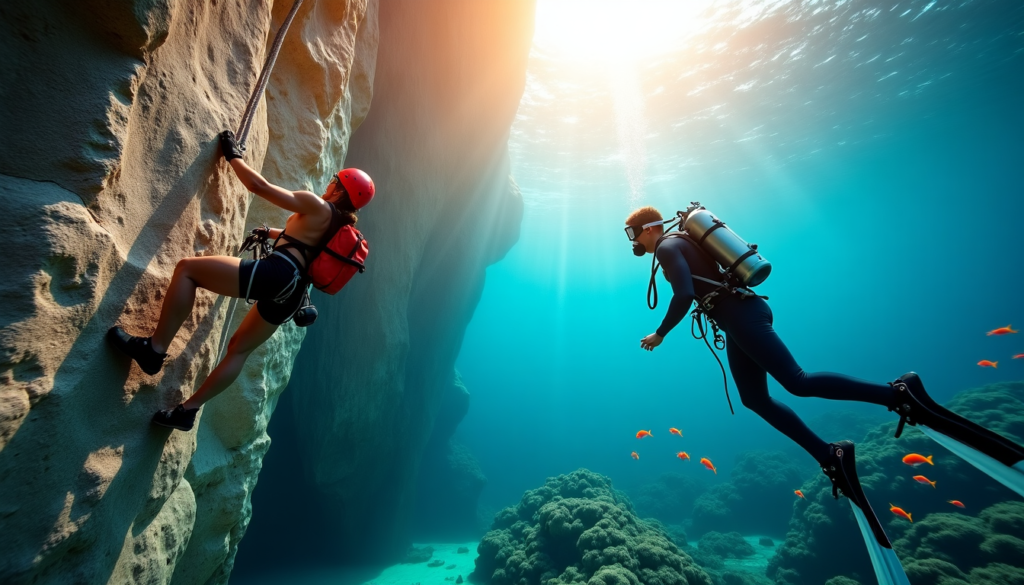
Adventure travellers increased by 213% in 2023, making travel insurance with adventure sports coverage more significant than ever. Standard travel insurance excludes high-risk activities like skydiving and backcountry skiing. Specialized coverage protects adventurers from much financial risk.
Adventure sports travel insurance should provide more than simple coverage. Providers like Faye are a great way to get protection up to $250,000 for accidents and sickness on international trips. Their coverage includes activities from mountaineering to scuba diving. The right travel insurance with adventure sports coverage protects you against emergency evacuations, medical expenses, and gear damage during domestic or international adventures.
Understanding Adventure Sports Coverage
Adventure sports insurance fills vital gaps that regular travel insurance policies leave out. Standard travel insurance plans need an extra rider at an additional cost to cover high-risk activities.
This protection covers many exciting activities such as:
- Mountaineering and rock climbing
- Scuba diving and underwater activities
- Bungee jumping and skydiving
- River rafting and kayaking
- Paragliding and parasailing
These specialized policies give you emergency medical coverage up to $100,000 if you get injured during covered activities. Emergency evacuation benefits can reach $250,000 or more. This becomes vital since adventure sports often happen in remote places where you can’t find immediate medical care.
These policies also protect your specialized gear and equipment. The coverage has accidental death and dismemberment (AD&D) benefits that give financial security to participants and their families.
Altitude coverage sets these policies apart from standard ones. Regular policies limit coverage to activities below 3,000 meters, while specialized adventure sports insurance can protect you up to 6,000 meters or higher. Recent data shows that emergency helicopter evacuations from remote areas can cost between $5,000 to $15,000, which makes proper coverage a necessity.
Coverage by Activity Type
Mountain climbers need special insurance based on how high they climb. Standard policies only cover up to 3,000 meters, while specialized mountaineering insurance protects climbers up to 6,000 meters. Anyone climbing Mount Kilimanjaro needs a policy that covers heights under 6,000 meters and includes emergency helicopter evacuation, which costs about $5,000.
Air sports insurance covers many different activities. The coverage includes common adventures like zip-lining and hot-air balloon tours. More extreme sports such as skydiving, hang gliding, and bungee jumping need specific hazardous sports protection.
Water activity coverage depends on risk level and depth. Simple policies cover shallow-water activities like snorkelling and kayaking. Deepwater adventures like scuba diving usually get coverage up to 30 meters in depth.
Here are the main coverage limits for activities:
- Emergency medical coverage: minimum $50,000 recommended
- Medical evacuation: minimum $100,000 recommended
- Search and rescue coverage: up to $50,000
Insurance companies split activities between normal and extreme categories, and prices change based on risk. Your policy might not cover certain high-risk activities unless they’re specifically listed. You should review your policy’s certificate carefully to check which activities are excluded before you buy.
How to Choose the Right Policy
You need to review multiple factors to pick the right adventure sports insurance. The original step is to look at your planned activities and figure out how risky they are to get the coverage you need.
Here are the main factors to review when picking a policy:
- Medical Coverage Limits – Ensure sufficient protection for injuries and evacuation
- Activity Coverage List – Verify all planned sports are explicitly included
- Geographic Scope – Confirm validity in your destination
- Equipment Protection – Check coverage for specialized gear
- Claims Process Efficiency – Research provider’s reputation for handling claims
You should buy your coverage right after booking your trip to stay protected against unexpected issues before leaving. A weekend camping trip needs different coverage than a month-long trek through Asia, so compare plans side-by-side to find your best match.
SquareMouth lets you filter insurance plans by specific activities, which makes finding suitable coverage easier. All the same, you need to read the policy documents, even if it feels boring. The exclusions and limitations change a lot between policies, so pay extra attention to them.
The best travel insurance for adventure sports gives you both great coverage and good value. Look for policies that offer 24/7 emergency assistance and medical care coordination, especially if you’re heading to remote places. Note that most U.S.-based healthcare policies don’t work overseas, so resilient medical coverage becomes vital for adventure travellers.
Conclusion
Adventure sports travel insurance is a vital safeguard for modern thrill-seekers. Simple travel policies might not cover everything, but specialized adventure sports insurance protects you during activities from mountaineering to deep-sea diving.
Coverage limits are significant for adventure travellers. Medical coverage of at least $50,000 and evacuation benefits of up to $250,000 give you peace of mind during high-risk activities. On top of that, it helps to have proper gear protection and activity-specific coverage to ensure security during adventures.
Smart travellers should review policy details before buying coverage. The fine print about excluded activities, altitude restrictions, and coverage limits helps prevent surprises during claims. Cost shouldn’t be your only factor – choose a policy that matches your adventure needs and destination requirements.
Note that adventure sports insurance works best when you buy it early and understand it well. The costs might seem high at first, but they’re minimal compared to emergency evacuation expenses or medical bills in remote locations. Your informed choice about adventure sports coverage today can protect your future adventures.
FAQs
Q1. Does travel insurance cover adventure sports?
Standard travel insurance often excludes high-risk activities, but specialized adventure sports coverage is available. This type of insurance can protect you during activities like mountaineering, scuba diving, and skydiving, offering coverage for medical emergencies, evacuations, and gear damage.
Q2. What are the typical coverage limits for adventure sports insurance?
Adventure sports insurance typically provides emergency medical coverage up to $100,000 for injuries sustained during covered activities. Emergency evacuation benefits can reach $250,000 or more, which is crucial for remote locations. It’s recommended to have a minimum of $50,000 for medical coverage and $100,000 for medical evacuation.
Q3. Are there altitude restrictions in adventure sports coverage?
Yes, altitude restrictions are common in adventure sports policies. While standard policies often limit coverage to activities below 3,000 meters, specialized adventure sports insurance can cover activities up to 6,000 meters or more. This is particularly important for mountaineering expeditions.
Q4. How do I choose the right adventure sports insurance policy?
To choose the right policy, assess your planned activities and their risk levels. Consider factors such as medical coverage limits, the list of covered activities, geographic scope, equipment protection, and the insurer’s reputation for handling claims. Compare plans side-by-side and read policy documents thoroughly, paying special attention to exclusions and limitations.
Q5. When should I purchase adventure sports travel insurance?
It’s best to purchase your adventure sports travel insurance as soon as you book your trip. This ensures protection against unforeseen circumstances before departure. Remember that most U.S.-based healthcare policies don’t extend coverage overseas, making robust medical coverage essential for adventure travellers.
